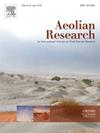用离散元法模拟上斜坡床上沙粒的气动夹带
IF 3.4
3区 地球科学
Q2 GEOGRAPHY, PHYSICAL
引用次数: 0
摘要
风沙输运是干旱半干旱区沙尘暴、土地退化等自然灾害发生的主要原因,其中气动夹带是一个关键的物理过程。虽然大多数关于气动夹带的研究都集中在平坦层上,但对斜坡层上沙粒的气动夹带研究尚不充分。采用离散元法建立了倾角为0°~ 20°的砂层模型,并对砂层的气动夹带过程进行了数值模拟。结果表明,坡角越大,对气动夹带的抑制作用越强。当坡角为20°时,与平坦层相比,倾斜层气动夹带的阈值摩擦速度和响应时间增加了约50%,而夹带速率降低了近90%。从颗粒运动的角度来看,倾斜床上的沙粒需要更多的能量才能脱离床层,导致滚动距离和碰撞次数比平坦床增加近55%。本文提出了一种斜坡地层的气动夹带方案,增强了对真实地形风沙运动的认识,提高了预测精度。本文章由计算机程序翻译,如有差异,请以英文原文为准。

Simulation of aerodynamic entrainment of sand particles on an up-sloping bed using the discrete element method
Aeolian sediment transport is the main cause of natural disasters such as dust storms and land degradation in arid and semi-arid regions, with aerodynamic entrainment being a key physical process. While most studies on aerodynamic entrainment focus on flat beds, the aerodynamic entrainment of sand particles on sloping beds remains underexplored. In this study, models of sand beds sloping at angles ranging from 0° to 20° were developed using the discrete element method, and the aerodynamic entrainment process on these beds was simulated. The results indicate that the inhibitory effect on aerodynamic entrainment increases considerably with slope angle. Compared to those for flat beds, the threshold friction velocity and response time of aerodynamic entrainment on sloping beds increase by approximately 50%, while the entrainment rate decreases by almost 90% at a slope angle of 20°. From a particle motion perspective, sand particles on a sloping bed require more energy to detach from the bed, resulting in an increase of almost 55% in rolling distance and number of collisions compared to that for a flat bed. In this study, an aerodynamic entrainment scheme for sloping beds was proposed, enhancing the understanding of wind-blown sand movement in real terrains and improving prediction accuracy.
求助全文
通过发布文献求助,成功后即可免费获取论文全文。
去求助
来源期刊

Aeolian Research
GEOGRAPHY, PHYSICAL-
CiteScore
7.10
自引率
6.10%
发文量
43
审稿时长
>12 weeks
期刊介绍:
The scope of Aeolian Research includes the following topics:
• Fundamental Aeolian processes, including sand and dust entrainment, transport and deposition of sediment
• Modeling and field studies of Aeolian processes
• Instrumentation/measurement in the field and lab
• Practical applications including environmental impacts and erosion control
• Aeolian landforms, geomorphology and paleoenvironments
• Dust-atmosphere/cloud interactions.
 求助内容:
求助内容: 应助结果提醒方式:
应助结果提醒方式:


